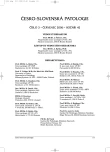The Molecular Genetic Assessment of Prognostic Factors in Carcioma of the Prostate: a Pilot Study
Authors:
J. Dvořáčková; Magdalena Uvírová
Authors‘ workplace:
CGB laboratoř spol. s r. o., Ostrava
Published in:
Čes.-slov. Patol., 42, 2006, No. 3, p. 130-132
Category:
Overview
The loss of the 8p22 chromosome part and amplification of the 8q24 region (c-myc oncogene region) are the most frequent chromosomal aberrations observed in prostate carcinoma. We aimed to demonstrate the frequency of these chromosomal abnormalities and to assess how they correlate with the prognosis in patients with prostate carcinoma.
From a set of 130 patients, we selected a group of 17 who died within five years after the diagnosis had been determined. Due to the lack of tumor cells in puncture biopsies, we managed to carry out in situ hybridization and assess the result objectively for 9 patients only. In seven cases, amplification of the region for c-myc oncogene was found; however, in five of them, polyploidy of chromosome 8 was manifested simultaneously. Deletion of the 8p22 chromosome part (region for the LPL gene) was found in five cases. A normal finding was detected in two cases. However, the analysis was carried out on a small number of cells gained from paraffin slices, so it was impossible to meet the requirement to examine 300 interphase cell nuclei. Therefore, we recommend to always determine whether the material taken is representative enough for this methodology and whether the tissue fixation is not inadequate or insufficient.
Key words:
loss of the 8p22 chromosome part – amplification of the 8q24 region – prostate carcinoma – prognosis
Labels
Anatomical pathology Forensic medical examiner ToxicologyArticle was published in
Czecho-Slovak Pathology

2006 Issue 3
Most read in this issue
- Sessile Serrated Adenomas of the Large Bowel. Clinicopathologic and Immunohistochemical Study Including Comparison with Common Hyperplastic Polyps and Adenomas
- Low Grade Myofibroblastic Sarcoma of Tongue: a Case Report
- Leiomyoma of the Gastrointestinal Tract with Intracytoplasmic Inclusion Bodies Report of Three Cases
- The Use of Immunohistochemistry in the Differential Diagnosis of Thyroid Gland Tumors with Follicular Growth Pattern
